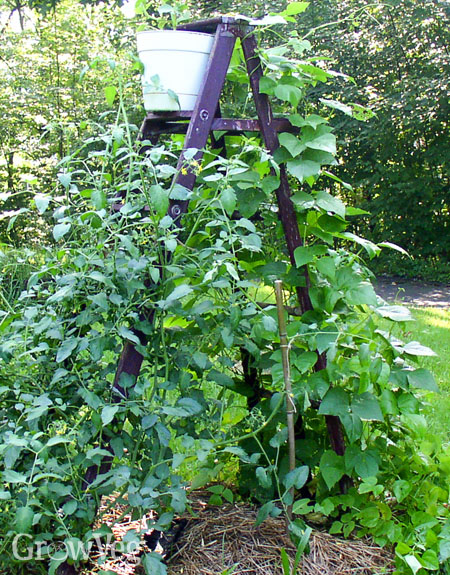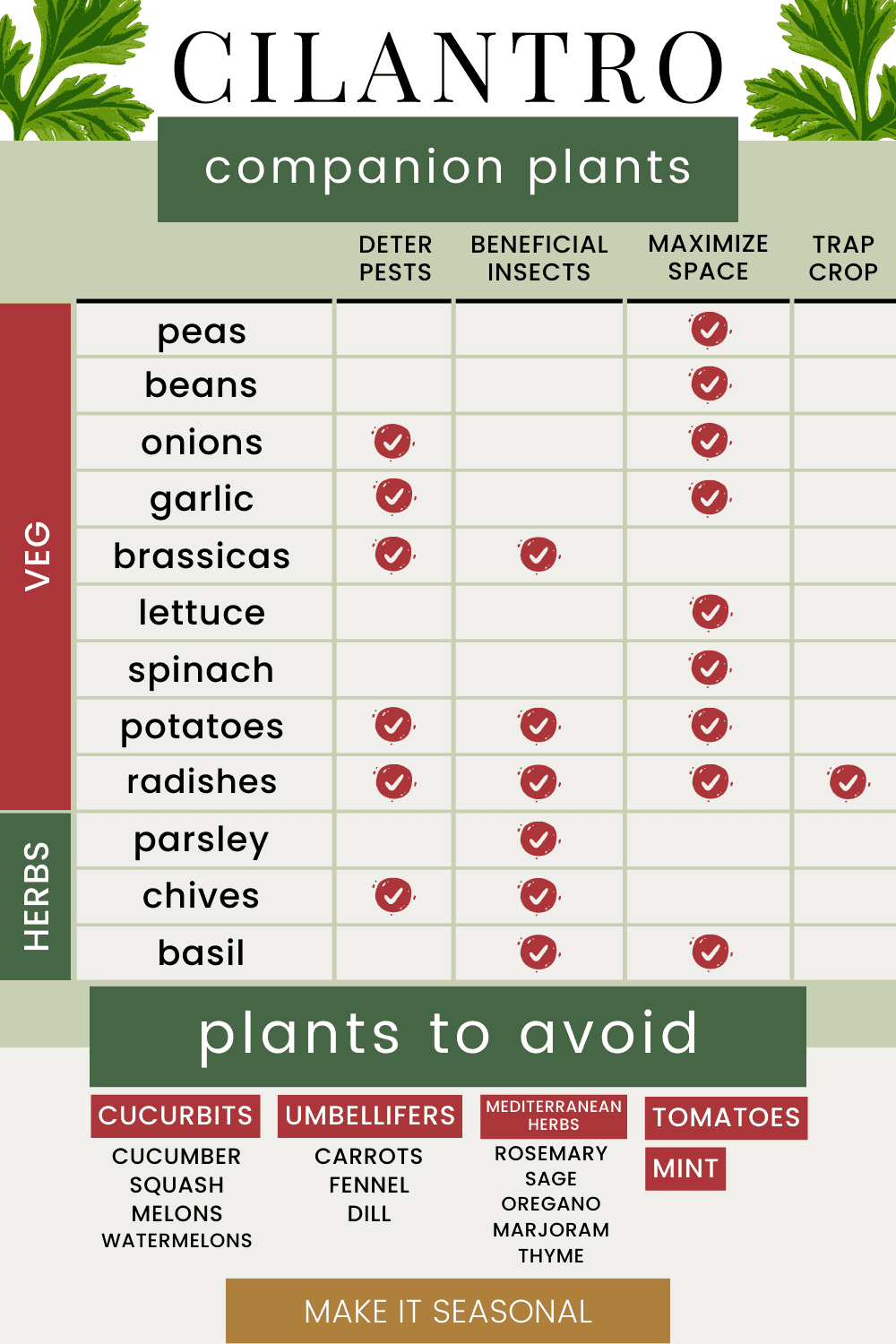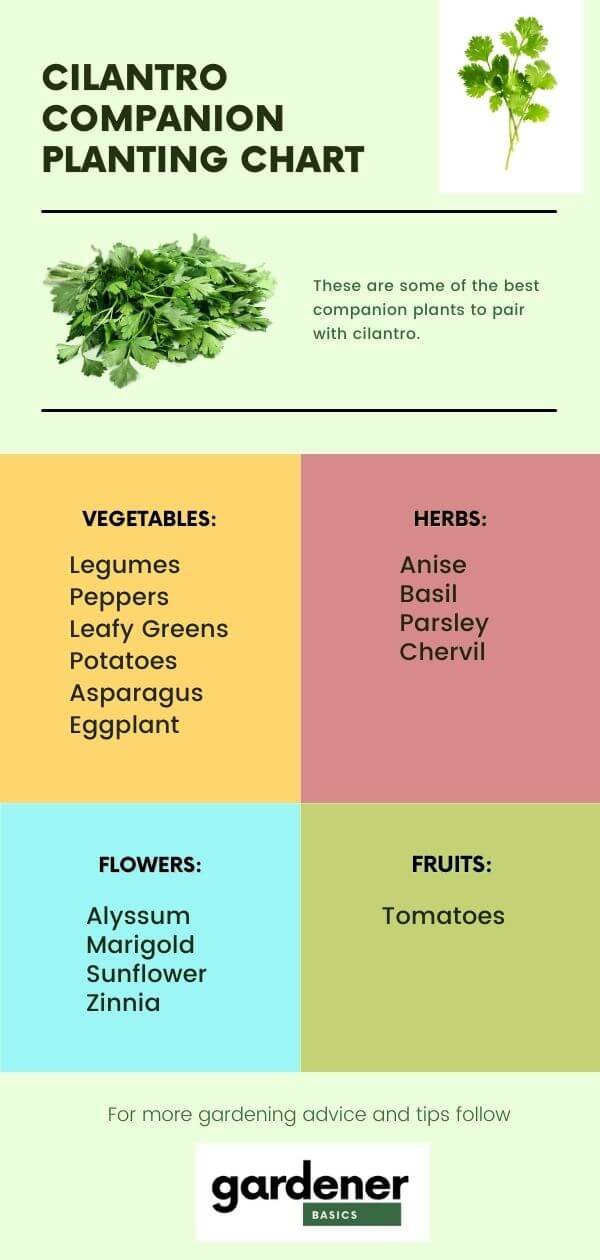The Best Companion Plants For Cilantro
The Best Companion Plants for Cilantro
Cilantro is a delicious and versatile herb that can be used in a variety of dishes. It is also a relatively easy plant to grow, but it can be susceptible to pests and diseases. One way to help protect cilantro from these problems is to plant it with companion plants.
Companion planting is the practice of planting certain plants together to benefit each other. Some plants can help to repel pests, while others can help to improve the soil or attract beneficial insects.
There are many different companion plants that can be grown with cilantro. Here are some of the best:
- Tomatoes: Tomatoes and cilantro are a classic companion planting combination. Tomatoes provide shade for cilantro, which can help to prevent it from bolting in hot weather. Cilantro, in turn, can help to repel tomato hornworms.
- Peas and beans: Peas and beans are legumes, which means they fix nitrogen in the soil. This can help to improve the soil quality for cilantro, which is a heavy feeder.

- Lettuce: Lettuce and cilantro are both cool-season crops, so they can be planted together in the spring or fall. Lettuce can help to shade cilantro from the hot sun, while cilantro can help to repel aphids and other pests.
- Carrots: Carrots and cilantro can be planted together because they have different root systems. Carrots have a taproot, while cilantro has a fibrous root system. This means that they will not compete for resources, and they can actually help each other to grow better.

- Basil: Basil and cilantro are both members of the mint family, and they can be planted together to help each other to grow better. Basil can help to repel pests, while cilantro can help to improve the flavor of basil.
- Marigolds: Marigolds are not edible, but they are a great companion plant for cilantro. Marigolds release a scent that repels pests, such as aphids, spider mites, and whiteflies.
Cilantro is a delicious and versatile herb that can be used in a variety of dishes. But did you know that there are certain plants that can help cilantro grow better? These are called companion plants, and they can provide a number of benefits, such as attracting beneficial insects, repelling pests, and improving the soil quality.
Some of the best companion plants for cilantro include:
- Tomatoes: Tomatoes provide shade for cilantro, which can help it to grow in hot weather.
- Potatoes: Potatoes add nitrogen to the soil, which is beneficial for cilantro.
- Asparagus: Asparagus helps to deter aphids, which can be a problem for cilantro.
- Dill: Dill attracts beneficial insects, such as ladybugs, which help to control pests.
- Basil: Basil and cilantro have similar growing requirements, so they can be planted together.
If you're looking to grow cilantro in your garden, be sure to consider planting some of these companion plants. You'll be glad you did!
For more information about cilantro planting companions, please visit Gardenia Inspiration.
FAQ of cilantro planting companions
Question 1: What are some good cilantro planting companions?
Answer: Some of the best cilantro planting companions include:
- Tomatoes: Tomatoes grow well in hot weather and provide shade to cilantro, which can help extend the growing season.
- Eggplants: Eggplants attract the same beneficial insects that cilantro does, so planting them together can help to protect your crops from pests.
- Peppers: Peppers and cilantro both benefit from the same type of soil and sunlight, so they make good companion plants.
- Potatoes: The predatory insects that are attracted to cilantro prey on Colorado potato beetles, protecting your potato crops from pests.
- Asparagus: Asparagus is a nitrogen-fixing plant, which means that it adds nitrogen to the soil. This can benefit cilantro, which is a heavy feeder.
Question 2: What herbs should I not plant next to cilantro?
Answer: Some herbs that should not be planted next to cilantro include:
- Fennel: Fennel has a similar flavor to cilantro, so planting them together can make your cilantro taste bitter.
- Lavender: Lavender has different water and soil requirements than cilantro, so planting them together can stress both plants.
- Thyme: Thyme can inhibit the growth of cilantro, so it is best to avoid planting them together.
- Rosemary: Rosemary has different water and soil requirements than cilantro, so planting them together can stress both plants.
Question 3: What are some benefits of companion planting with cilantro?
Answer: There are many benefits to companion planting with cilantro, including:
- Increased crop yields: Companion plants can help to attract beneficial insects, which can help to control pests and improve pollination. This can lead to increased crop yields.
- Improved soil health: Companion plants can help to improve soil health by adding nutrients and organic matter. This can make the soil more fertile and productive.
- Reduced pest problems: Companion plants can help to attract beneficial insects, which can help to control pests. This can reduce the need for pesticides, which can be harmful to the environment.
- Enhanced flavor: Some companion plants can enhance the flavor of cilantro. For example, tomatoes and peppers can add a depth of flavor to cilantro.
Question 4: How far apart should I plant cilantro and its companion plants?
Answer: The spacing requirements for cilantro and its companion plants will vary depending on the specific plants involved. However, as a general rule, you should space cilantro plants about 6 inches apart and its companion plants about 12 inches apart. This will give the plants enough room to grow and thrive.
Question 5: How do I know if I'm planting cilantro and its companion plants correctly?
Answer: There are a few things you can look for to see if you're planting cilantro and its companion plants correctly. First, the plants should be growing well and free of pests. Second, the plants should be spaced correctly. Third, the plants should be getting the right amount of sunlight and water. If you're seeing any problems, you may need to adjust your planting practices.
Image of cilantro planting companions
- Anise: Anise is a lesser-known herb that grows in the same cool-weather conditions as cilantro, and planting cilantro near anise can help anise seeds to germinate quicker and more effectively.
- Dill: Dill is a classic companion plant for cilantro, as the two herbs help to repel each other's pests. Dill also helps to improve the flavor of cilantro.
- Leafy vegetables: Leafy vegetables, such as lettuce, spinach, and kale, can be planted near cilantro to help suppress weeds and improve the overall health of the plants.
- Legumes: Legumes, such as beans, peas, and lentils, can be planted near cilantro to help improve the soil nitrogen levels.

- Tomatoes: Tomatoes and cilantro are both warm-season crops that can be planted together. Tomatoes help to deter pests from cilantro, and cilantro helps to improve the flavor of tomatoes.

Post a Comment for "The Best Companion Plants For Cilantro"